With a huge amount of settings to master in Google Ads, it is easy to get lost when setting up a display campaign. Even if it is not your first GDN campaign, you can still struggle with task prioritization, figuring out the right boxes to tick and the right options to choose; this is why we developed the step-by-step checklist below. You just need to choose the primary goal of the campaign and we will generate an actionable how-to guide to help you at every stage, from choosing the right audiences to fine-tuning the landing pages. You will be able to check the completed tasks to track your progress and see how many steps are left to completion.
[gdn-checklist-en]
Выберите задачу
Launch a new product Expand to new audiences Explain product value Promote an offer to an existing audience Convert bounced users Close the deal Target users who performed a specific action Retain customersDemographics
Готово
Demographic targeting is like a frame you use before starting to explore other targeting options. Most likely, your company has already defined its target audience and developed a user (or buyer) persona. This persona usually has many characteristics, but almost all the time the description starts with age, gender, and income level. This is why, when setting up a campaign, we recommend you to keep this data in mind and apply these filters first.
Источник: https://www.myproductroadmap.com/Previously, in Google Display Network demographic targeting included only age and gender filters. Now it is more detailed — you can target by parental status, marital status, home ownership, and education level.
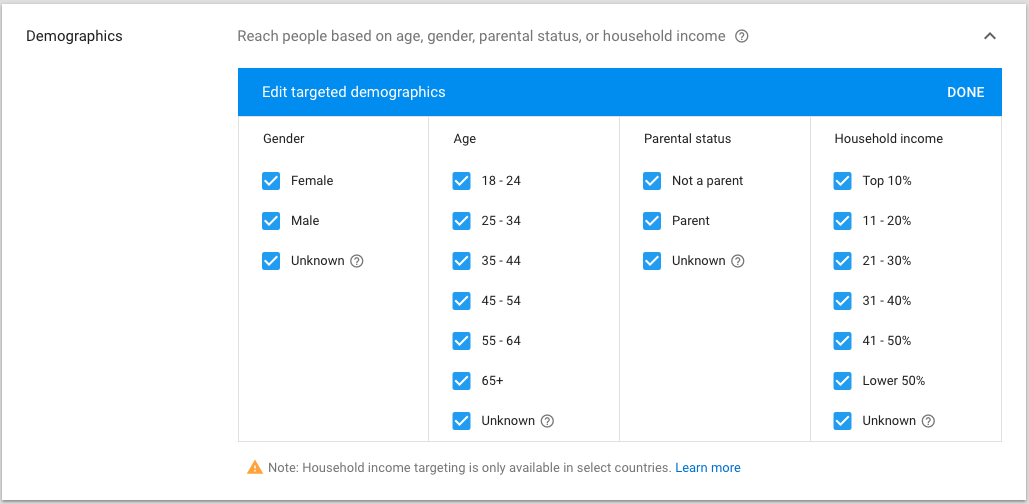
Targeting by a life event is another powerful method in GDN. It allows you to identify those who:
Have recently graduated from college or are about to graduate. Have just got married or are planning to. Had a baby or are going to soon.By developing personalized ad creatives for these audiences (see the 'Ad Creatives' section of the checklist) you will be able to raise your CTR and conversion rate. A hotel or a car rental company, for example, can launch a campaign aimed at couples who are planning their honeymoon trip, highlighting some special offers.
ГотовоInterests
Готово
Interest-based targeting is always a strong choice for display ads, increasing the likelihood that your ad will be shown to someone who would take action on it. You can target generic interests like “Business Professionals,” or get specific with options including “Banking & Finance.

This tactic is great if you’re targeting cold audiences who come from a variety of demographics, but typically have niche interests. Some people would never dream of dropping $500 on a blender, for example, if you target users who are “Cooking Enthusiasts,” you will have a better chance of striking gold with a successful campaign.
Useful tip: sometimes you see that the audience you chose is too narrow. So if you need to expand the coverage of your ads, you can try other audiences that are not directly related to your target customers, but still can be relevant. Our Display Advertising tool will help you with some insights. Type in your competitor's domain name and explore the most popular topics of the publishers placing this domain's ads.
Исследовать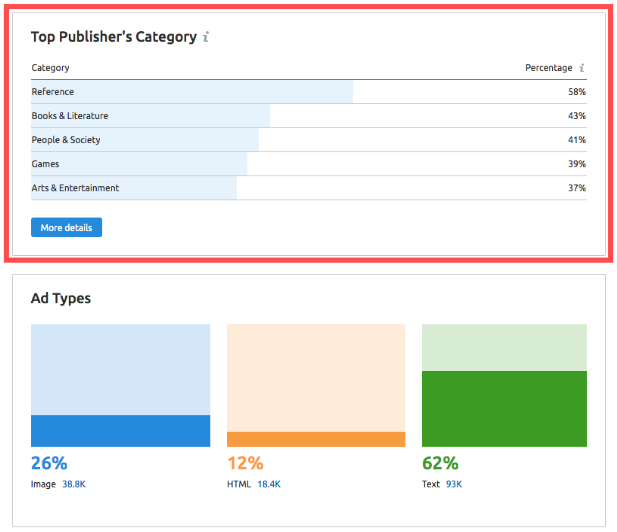
In-market audiences
Готово
This is a valuable audience targeting tactic that allows you to show your ad to users who are currently in the market for products or services like yours. These people are actively researching and planning on making a purchase soon, and this targeting option gives you a chance to ensure that you are in the running.
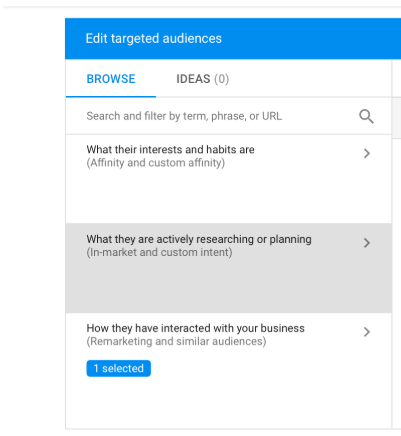
Even if you don’t see your specific products categories listed, you can still get creative here. If you see strollers, for example, but don’t see a category for this specifically, you can still target users who are researching “Infant and Toddler Feeding” and “Diapers & Baby Hygiene Products.” They are still your target audience, and this gives you a way to reach them.
Готово3rd party audiences
Готово
Third party audiences are a little like custom lists audiences, but these customer lists are purchased from third-party sites. The lists will match the demographics of your typical site visitors or customers, and it will contain a list of cookies for individual users, allowing you to target them with ad campaigns.
To use third-party audiences, you need to work with a data provider. This is easiest to do when they are integrated through the Ads Manager (you can also be sure that these audiences are GDPR compliant), allowing them to automatically send you these lists where you can review or reject them.
ГотовоCustom intent audiences (ex Audience keywords)
Готово
This audience type lets you target users who are searching for specific keywords in their research and planning cycle, giving you the chance to serve display ads while utilizing some of the best elements of search ads — harvesting demand instead of having to generate it outright.
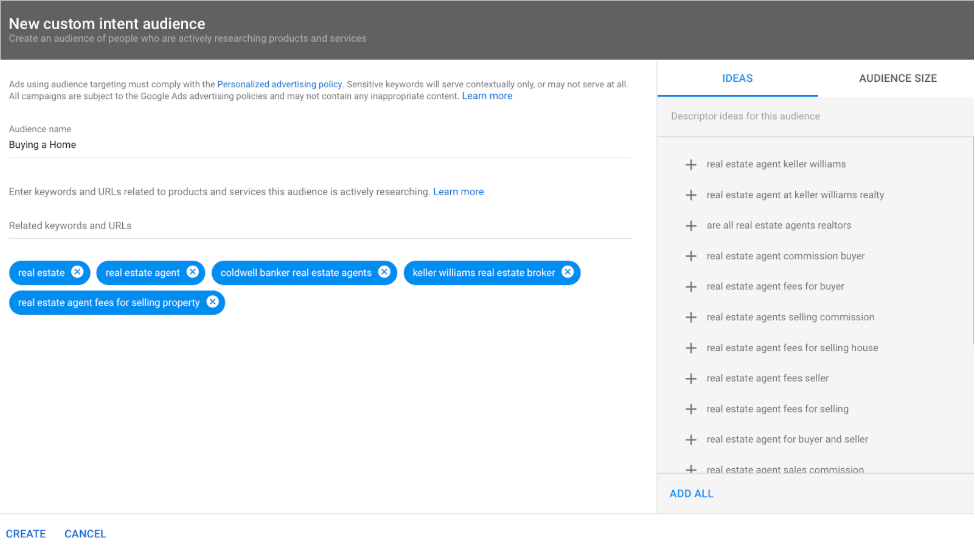
Custom intent audiences are relatively new, and you get to select the exact keywords you want your campaigns to focus on. As you do so, you will get to see the estimated audience size and their demographic breakdown to ensure you’re on the right track."
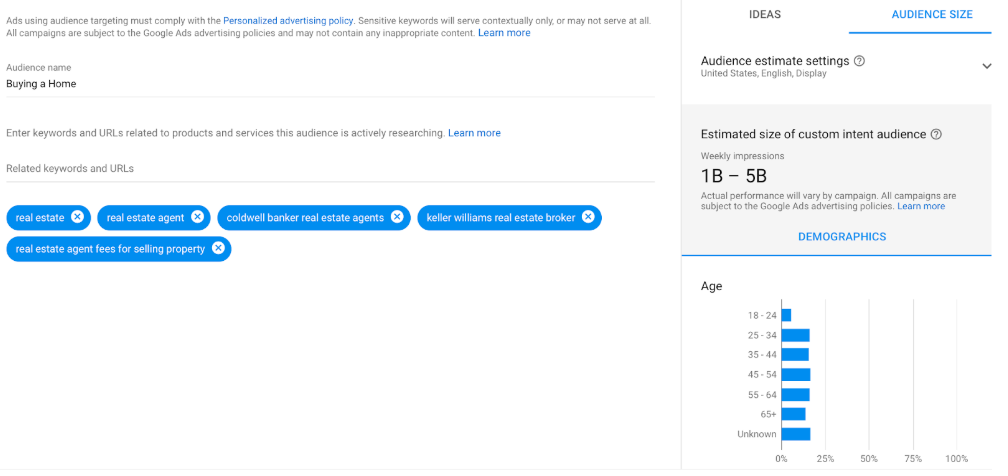
Look alike / similar audiences
Готово
Google’s similar audiences give you a way to connect with users who are similar to your most high-value customers. You can create these audiences to resemble your first-party custom audience lists, giving you the option to target similar users with the benefit of enormous reach.
Since these new customers may be unlikely to have a relationship with you, this is an excellent tactic to reach cold audience members that would have a stronger chance of being interested in what your business has to offer.
Note that these similar audiences won’t automatically yield the same results as a remarketing campaign, where the users are already “warm” or “hot” and have some sort of relationship with you. This isn’t action-based targeting, after all, and sometimes the results can be a little unpredictable. Keep a close eye on these campaigns, and set bid limits if you feel more comfortable doing so.
ГотовоTargeted placements
Готово
This is a very granular tactic allowing to target the audience of a specific website, app category, or YouTube channel. You can choose to target the root domain or channel, but it can be even narrowed down to specific URLs, apps and videos.
If you decide to take on managed placements, you should remember that adding just a couple of websites to the list won't help. Use multiple sources to get a robust list of placements to target: - Referrals - the websites that are already linking to you can be hidden gems in terms of audience. Just make sure they are part of Google Display Network. - Competitor research is vital if you want to find the websites your rivals are targeting. With SEMrush, you can reverse engineer your competitors’ GDN strategies.
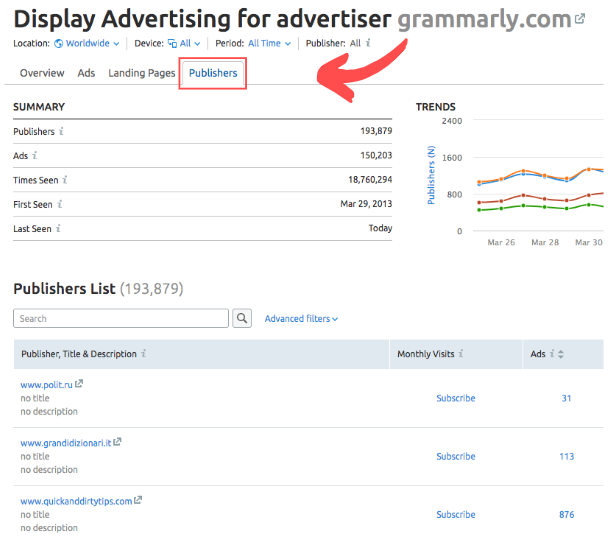
The ‘Publishers’ report will show all the websites the competitor’s ads were spotted on. You are also able to sort these websites by the number of ads from the analyzed advertiser and the time an ad was seen. It's also vital to check the traffic volume of the publishers you'd like to add as managed placements. SEMrush Traffic Analytics will help you do that.
ГотовоSite visits (for small audience)
Готово
This is the most basic remarketing technique. If you have just several hundreds of visits to your entire site per month, breaking them down into groups won't make sense, as the audiences would be really small. Google requires your website to have at least 100 visits during the last 30 days to set up a remarketing campaign - this is something you can start with.
You can create remarketing audiences right in Google Ads. In your Ads account, you need to go to Shared Library -> Audience Manager and can choose from the automatically created audiences or create your own.
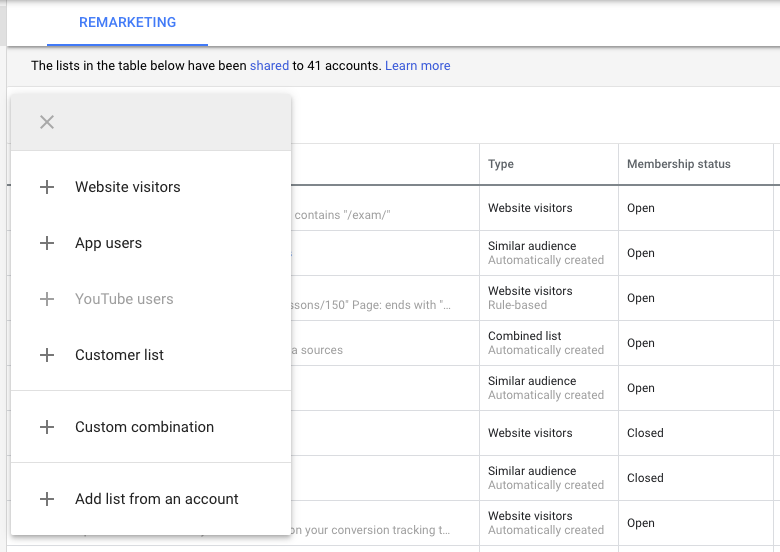
Actions on site
Готово
Remarketing is a valuable tool that allows you to show highly relevant ads to users who have taken specific actions on your site. If someone has visited your landing page but didn’t convert, for example, you could show them a display ad with new offers, enticing them to come back and purchase.

Your best bet here is to create specific campaigns targeting individual sites visited, as this will help you create ad copy that your audience is responsive to. The pages your audience visits or actions they take can also indicate where they are in the funnel, which will also be useful in developing the right ads.
ГотовоCustomer lists
Готово
In addition to target customers who have interacted with you recently online or through some of your marketing channels, you can also create audiences from lists in your CRM system.
This is excellent option, because you’ll have created the lists yourself. You know exactly which users are on it and what their relationship with your business currently is. This could include, for example: Leads that haven’t yet converted Customers who have purchased specific types of products Long-time customers who need to be alerted to new products or re-engaged.
The amount of information you have with customer lists is exceptional, and it gives you a chance to create strong campaigns that will appeal specifically to the exact users on your list.
ГотовоDynamic remarketing
Готово
You’ve almost certainly noticed dynamic remarketing display ads, because they’re used to show people the exact products or services they recently viewed online. You look at a pair of boots online, and the next day you see an ad for that exact pair of shoes and possibly a few similar to it in your sidebar.
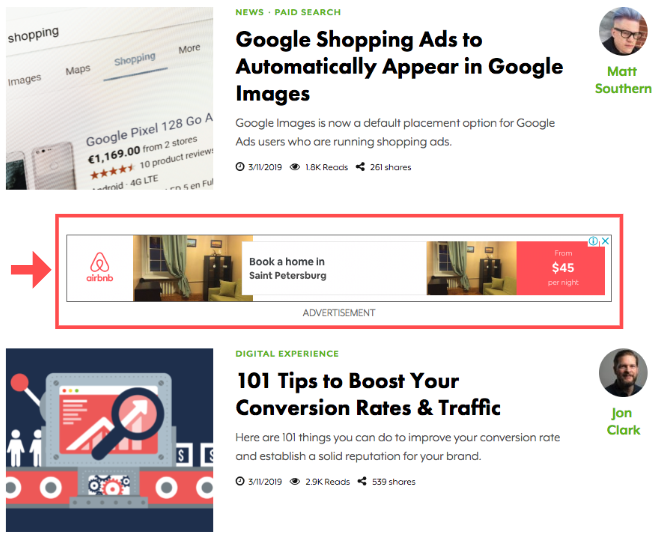
These ads can be unbelievably effective, taking users who were interested enough to view a specific product but not convert, and then nudging them with a gentle reminder of what’s still waiting for them. One study found that this targeting option increased Campmor’s ad results, yielding a 300% higher CTR, a 15% higher conversion rate, and a 37% decrease in CPC.
These campaigns should always be used to re-engage abandoned cart users, which can be an enormous source of profit when you successfully bring them back to your site.
ГотовоAudience Exclusions
Готово
While you’re choosing who you do want to target, you also have the option to set parameters that determine who you don’t want to target, even within those niches. You can do this at the account, campaign, and group levels, choosing to exclude certain users from seeing your ad campaigns.
Examples of who you might exclude are: - Users who have already seen your “thank you for ordering” page, meaning that they’ve already converted on an offer and don’t need remarketing campaigns trying to get them to purchase. - Specific locations, like zip codes or cities that are outside your delivery zones, even if all the surrounding areas are within them. - Individual placements, such as exact websites that you don’t want to advertise on, such as a site whose beliefs don’t align with your brand or is even offensive to your audience.
Exclusionary targeting can be just as powerful as inclusionary targeting, because it gives you maximum control over who is-- and who isn’t-- seeing your ads. This keeps your placements relevant and gives you the maximum chance for success.
ГотовоAudience Combinations
Готово
The default targeting options can be combined together to better target prospective customers. Here are some handy combinations to get your started on The Google Display network: - Target age + gender + affinity audience category - Affinity audience + managed placements - Custom affinity audiences - select at least five different interests, URLs, places or apps that you feel best describe your audience. - All of the above + previous actions on your site (for example, women with 'Parent' status who have recently visited the 'Christmas gifts' section)
To read about audience combinations in more detail, read this all-encompassing guide to boosting GDN performance.
To read about audience combinations in more detail, read this all-encompassing guide to boosting GDN performance.
ГотовоLeverage all available formats
Готово
When it comes to display advertising, your best bet is to take advantage of all the ad formats available to you, including responsive ads, image ads, and video ads.
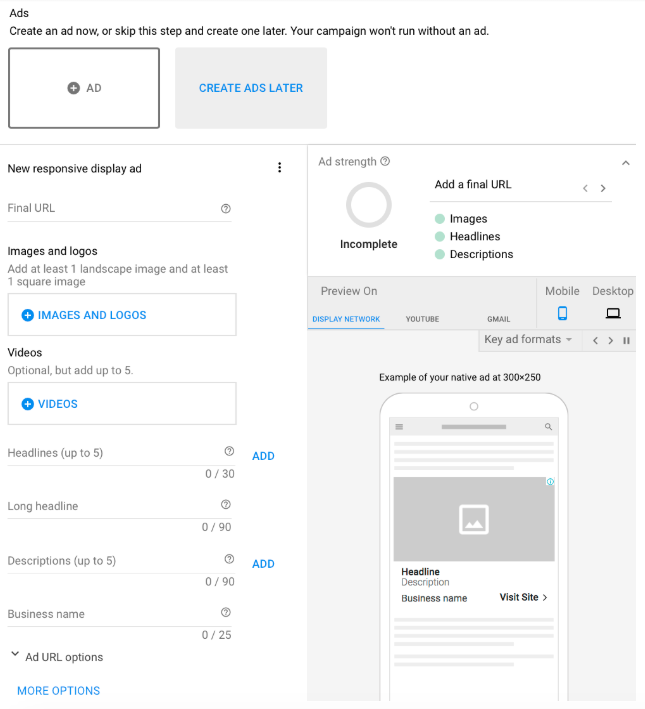
While it does take longer to create multiple ad versions for every campaign, it’s essential to test all of your options. You never know what format will work better, and which audience will respond and why. Testing is the only way to determine this for sure, and giving yourself all the data possible by trying out all of your options will work well in your favor.
ГотовоExplore competitors
Готово
Checking out what your competition is up to will be an important part of the ad creation process. You want to take a look at the messaging they’re using, which ad formats they’re focusing on, the offers they have available, and what CTAs they’re optimizing for.
You can use the Display Advertising tool to search for any of your competitors and review their ad campaigns, including image, HTML, and text ads. Understanding what your competitors offer can give you insight into what’s happening in your market, giving you the information you need to level the playing field and offering something different (and better!).
ГотовоProvide several variations for A/B test
Готово
A/B testing (also known as “split testing”) involves creating multiple variations of an ad campaign to see what your audience responds to and why. You should run tests to evaluate what types of visual components, colors, CTAs, and messaging your audience is most responsive to, because there’s no other way to find out except to see the clicks coming in.
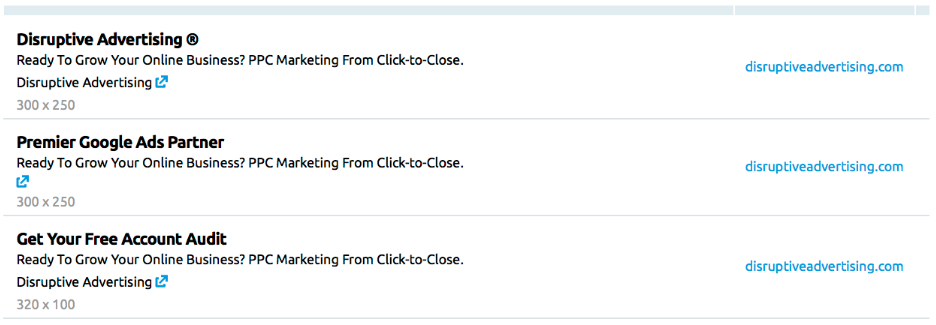
Note that when you’re running A/B tests, you should create a campaign and only change one single variable at a time. You can have multiple versions of that single variable change, but if you switch up too many aspects in the campaign you won’t be able to tell what’s causing the reactions. If you’re switching up the visuals, for example, you can try out 15 different images, but that’s all you’ll want to change.
ГотовоUse high-quality images
Готово
High quality images or videos are essential to getting those clicks. Anything that’s blurry or cropped at an odd angle won’t capture users’ attention, and if it does, it won’t be in a positive way. Opt for high-resolution visuals that are distinctive, easy to make out, and have plenty of white space. This can be simple, like the example below:

Note that all image files must be 150 KB or under; if they’re larger than that, they’ll take too long to load and Google may not approve the ad. For best results, choose PNG or JPG file types, which will help carry over high quality images.
ГотовоWrite a cool text
Готово
"No one reads texts anymore, it's all about visuals". We've all heard it, but in reality, texts and images work best when they are aligned. The text still attracts attention and communicates the core value of the product or service you advertise. This means you should think twice before just relying on a cool visual and putting another ordinary phrase as your main message.
The text makes all the difference in this ad from GoDaddy:
Let's see what makes this ad special: - Price. This is still the most powerful trigger for almost every person seeing your ad. Especially when the price is unreasonably low, which makes you think that you probably need to buy this thing you haven't thought about just a few seconds before. - CTA. It is clear, visible, and located next to the company's logo. So it gives you an idea of what will happen after you click the banner. - Brand presence. Regardless of the goal of a particular campaign, display advertising is also about branding. This is why having a company logo on the banner is always a good idea. - Unusual ad copy. Not every ad you see is as witty as this one, however, you can always think how to tweak the boring unique selling propositions you have been given by the brand manager.
ГотовоCTA button
Готово
This is the most important element of the landing page, which should be visible on any device. Make sure the button is not covered by a live chat window or other elements (this can happen if you don't test different screen sizes).
Another trick is adding a bit more value than expected. In the example of a Netflix landing page, they could just use the standard "Join now" CTA. But instead, they went a bit further by highlighting that the viewer can get a free month of service:
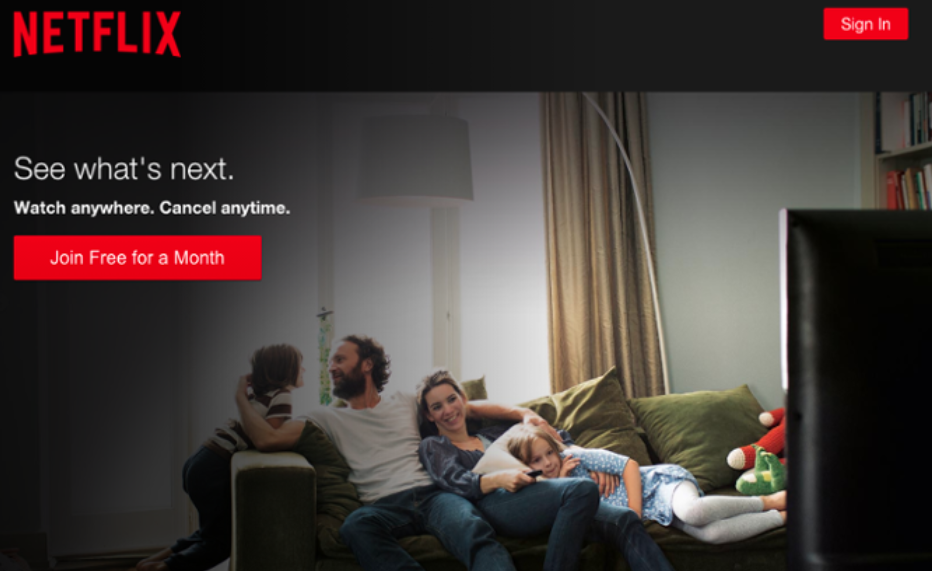
Content relevance
Готово
Visuals. You will have just a couple of seconds of a viewer's attention to demonstrate that the page is relevant, so if you advertise fishing equipment, make sure that the images on the page are related to fishing.
Offer a clear headline corresponding to the ad creative. According to Wordstream, most of converting headlines belong to one of these 5 categories:
- Clear value. It does not have to be necessarily what you define as traditional conversion. For a bank, the final goal is a loan application; however, as an immediate value the visitor can use the loan calculator in exchange for a phone number or email. Another example is a quick price estimator from a mover matching service:
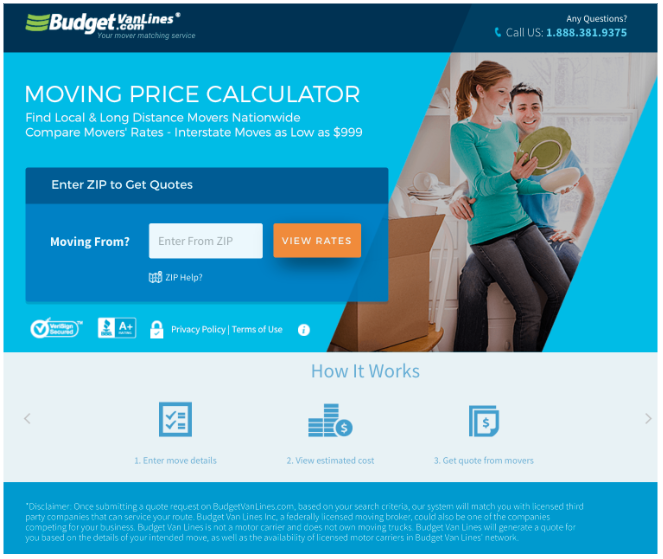
Load speed
Готово
Every second it takes your landing page to load (on mobile) leads to a 20% conversion drop. Load speed is also a landing page factor for Google Ads, which means you will be losing money (and rankings) because of poor technical performance. There are several ways to assess the load speed of your landing pages:
In Google Analytics under ‘Behaviour -> Site Speed -> Page Timings' In SEMrush Site Audit in the 'Errors' list: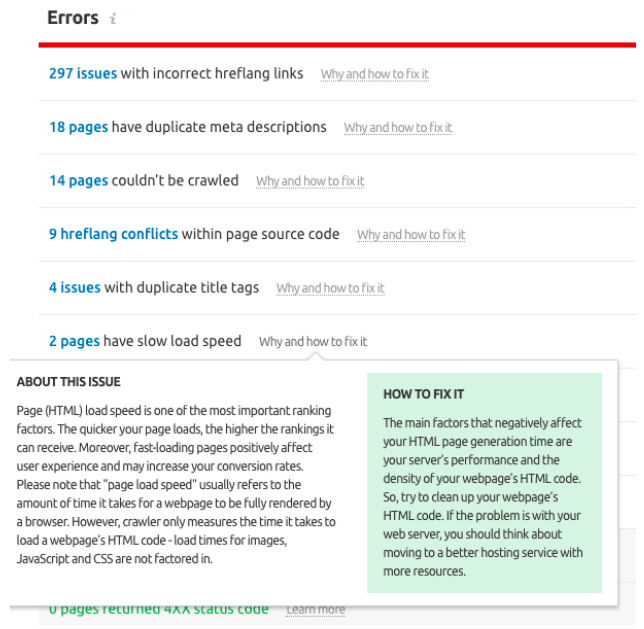
Device compatibility
Готово
Unless you are running a campaign strictly targeting desktop users, device compatibility is crucial (and you will need to deal with different browsers anyway). The number one thing to check when adding a CTA, a live chat, a web form, or anything else to a webpage or a landing page is the compatibility for browsers and devices. Every person that clicks on your ad needs to be lead to a functional webpage.
You can find detailed instructions for landing page testing in Search Ads 360 Help
ГотовоAd scheduling
Готово
Ads scheduling is an important decision. Not only does it involve when you want your campaigns’ start and end dates to take place, but it also can involve factors like dayparting or adjusting the bid for peak time periods.
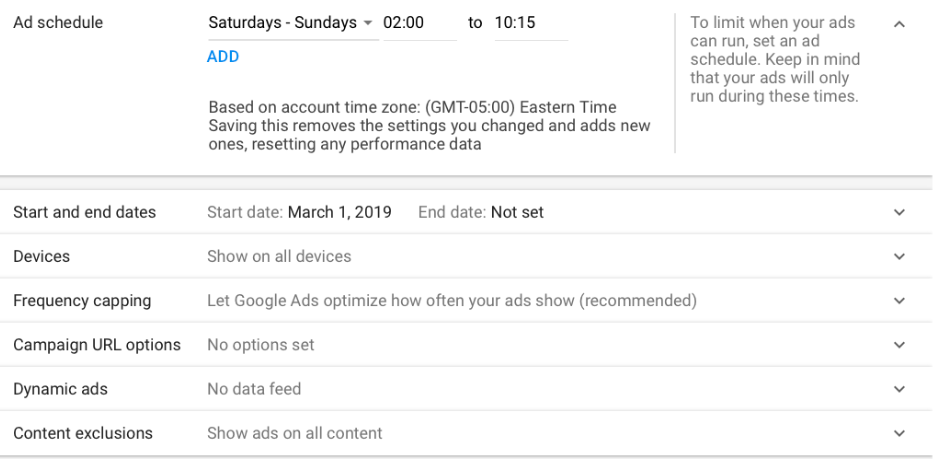
Dayparting is the practice of having your ads show up only at certain hours of the day or days of the week, or both. The idea is to have your ad appear during peak hours when users are most likely to see them or convert.
Whether you use complicated ad scheduling will depend on your specific business. A good example of when to use it would be an overnight emergency vet targeting keywords like “vet near me open now.” Ecommerce businesses, however, who typically accept sales at all times of the day don’t need to worry about this.
ГотовоFrequency capping
Готово
Frequency is the metric that tells you how often the same user sees the same ad. You don’t want to have frequency that’s too high, because after the user sees the same ad an average of four times within a set period of time, the likelihood that they’ll convert drops off.

You have the option to setting a frequency cap for your ad campaigns, limiting impressions to a set number, either permanently or within a set time frame. While you may be tempted to set your frequency to 1 impression per day, this can backfire; someone may click on your ad, go to do more research, and then be unable to find you again.
ГотовоDevices
Готово
Device targeting allows you to choose if you want to show your ads to users who are on specific devices or not. Your options include computers, mobiles, and tablets, along with specifying different operating systems, exact models of each device, or certain networks.
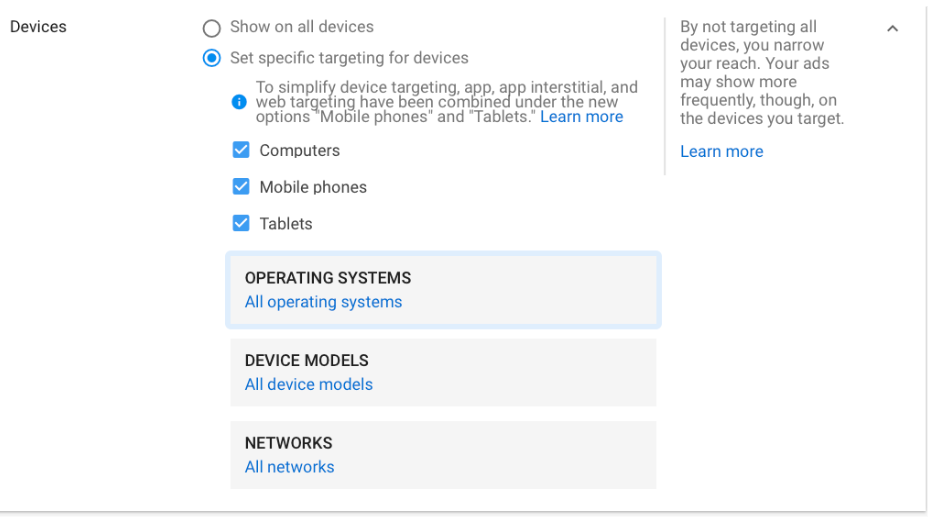
If you aren’t sure what devices you should be targeting, you can use the Display Advertising tool to see which ones your competitors are going after. That will help you decide what devices to target, if you choose to get specific, and if you want to change up your strategy for the creative portion of the ad depending on the devices you choose.
ГотовоBid adjustments
Готово
Your bid determines how much you’re paying for actions that you’re optimizing for, which are often clicks on your ad campaign. It’s important to find the perfect balance of a bid that’s high enough to get placements but low enough that you profit.
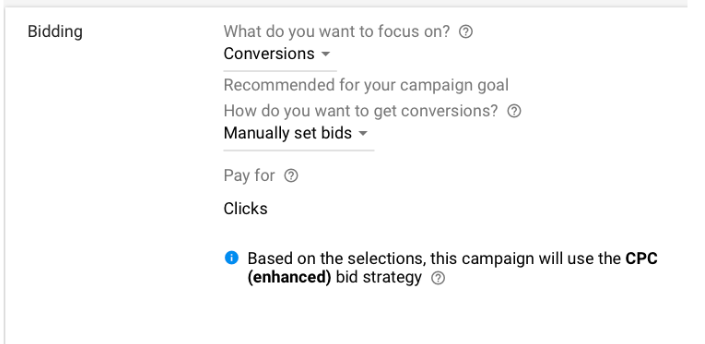
It’s also important that you choose the right bidding strategy, which will help you optimize for specific actions. Some will allow you to set exact bid limits, while others will focus on hitting a target return on ad spend or maximizing impressions.
While you should pick the strategy or bid that makes sense of the beginning of the campaign, it’s normal to have to modify it after the campaign begins. Adjust as you see fit once the campaign is live.
ГотовоEvents and tracking set up
Готово
Before your campaigns start running, it’s essential to ensure that proper tracking measures have been put in place. This will include installing Google’s tracking pixel on your website so that you can assess how successful your campaigns were at not only generating clicks, but driving specific actions.
Fortunately, most businesses already have tracking in place because they’ve installed the pixel when they set up their Google Analytics account. If you want to, you can also create UTMs for enhanced tracking, giving each campaign their own individual UTM tracking code for even more advanced analytics.
ГотовоBulk actions
Готово
You can set “bulk actions” or “bulk edits” that essentially act as blanket rules across multiple campaigns, ad groups, or ads. You can, for example, add negative keywords to multiple ad groups at a time, or apply scripts to your campaigns that automate common procedures like pausing or starting campaigns.
This is often more advanced on the marketing side; none of these actions are applied on a default basis, and they typically require Google Ads experts to tackle in some instances. That being said, if you’re running campaigns at a massive scale, these are good options to look into to streamline and automate your campaigns. Remember that no matter how great your scripts are however, you should always monitor them closely, too.
ГотовоLabels
Готово
When you’re creating your campaigns, your ad groups, and the ads themselves, don’t just resort to generic names like “Traffic Campaign 1.” That’s fine if you only have one traffic campaign and never want to run Google Ads again, but once you’re up to “Traffic Campaign 10,” they become impossible to keep up with. And you definitely don’t want this:
Give specific labels for every campaign, ad group, and each ad so that you can find, manage, and evaluate them quickly and easily. Opt for names like “Display Ad, March Webinar Registration, Video Ads,” which are specific and searchable. And if you’re working with a team, have a clear system of how exactly you want to create the labels so that everyone is on the same page.
Готово 1Audience Targeting Demographics Interests In-market audiences 3rd party audiences Custom intent audiences (ex Audience keywords) Look alike / similar audiences Targeted placements Site visits (for a small audience) Actions on site Customer lists Dynamic remarketing Audience Exclusions Audience Combinations 2Ad Creatives Leverage all available formats Explore competitors Provide several variations for A/B test Use high-quality images Write a cool text 3Landing Pages CTA button Content relevance Load speed Device compatibility 4Campaign settings Ad scheduling Frequency capping Devices Bid adjustments Events and tracking set up Bulk actions LabelsKey Takeaways (explore the checklist for more details and actionable tips)
GOAL: Launch a New Product
If you want to launch a new product, most likely you will need to define the target audience from scratch. Among dozens of audience targeting options, the most relevant ones are:
Demographic targeting - It is like a frame you use before starting to explore other targeting options. Previously, you could only choose age and gender filters, but now it is much more detailed: you can target by parental status, marital status, home ownership, and education level.
Targeting by Interests - This option will help increase the likelihood that your ad will be shown to someone who would take action on it. You can target generic interests like “Business Professionals,” or get specific with options including “Banking & Finance.”
In-market Audiences - By choosing this targeting method, you can reach people who are actively researching and planning on making a purchase soon, so this option gives you a chance to ensure that you’re in the running.
3rd Party Audiences - Third party audiences are a little like custom lists audiences, but these customer lists are purchased from third-party sites. The lists will match the demographics of your typical site visitors or customers, and it will contain a list of cookies for individual users, allowing you to target them with ad campaigns.
Custom Intent Audiences - (ex-Audience keywords). This audience type lets you target users who are searching for specific keywords in their research and planning cycle, giving you the chance to serve display ads while utilizing some of the best elements of search ads: harvesting demand instead of having to generate it outright.
Look-alike (or similar) Audiences - Google’s similar audiences give you a way to connect with users who are similar to your most high-value customers. You can create these audiences to resemble your first-party custom audience lists, giving you the option to target similar users with the benefit of enormous reach.
Targeted placements - This is a very granular tactic allowing to target the audience of a specific website, app category, or YouTube channel. If you decide to take on this targeting option, you should remember that adding just a couple of websites to the list won't help. Use multiple sources to get a robust list of placements to target: referrals (the websites that are already linking to you) and competitors (competitor research is vital if you want to find the websites your rivals are targeting).
With SEMrush, you can reverse engineer your competitors’ GDN strategies. The ‘Publishers’ report will show all the websites the competitor’s ads were spotted on. You are also able to sort these websites by the number of ads from the analyzed advertiser and the time an ad was seen:
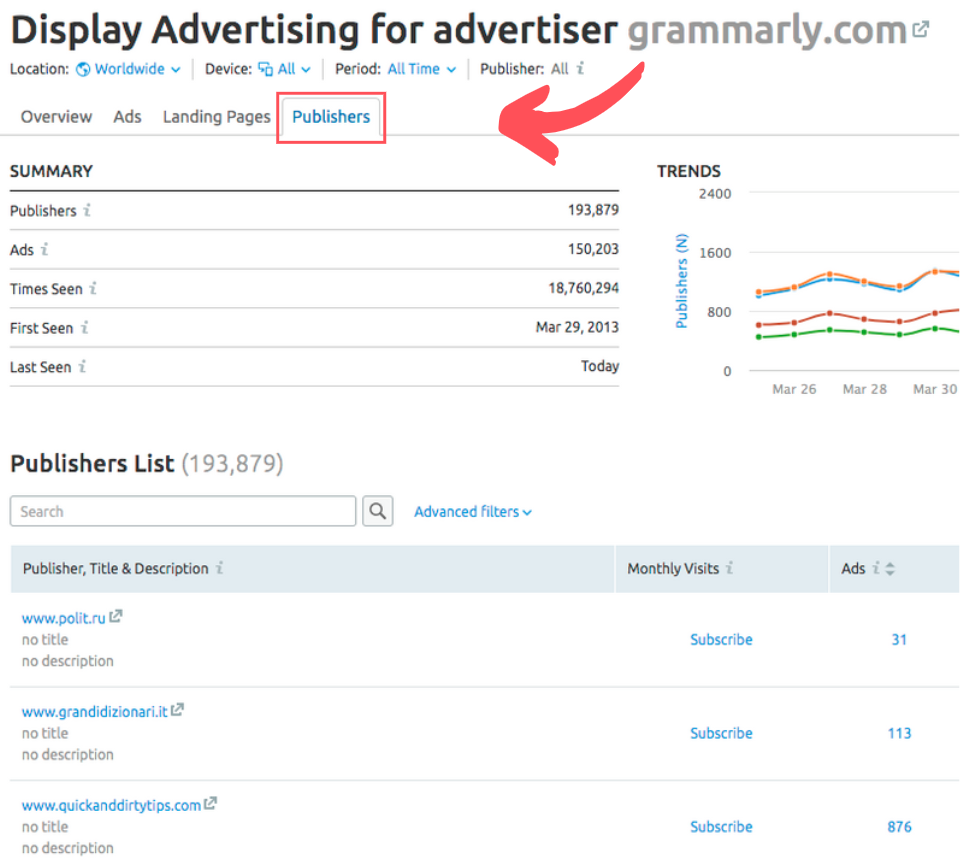
It is also vital to check the traffic volume of the publishers you'd like to add as managed placements. SEMrush Traffic Analytics will help you do that.
Various Audience Combinations: to read more about the top combinations, read this all-encompassing guide to boosting GDN performance.
GOAL: Expand to New Audiences
You already have a certain amount of traffic coming to your website, but it's not enough: you need to reach new users. Display campaigns are a great way to expose your products or services to new audiences. These are the targeting options you can leverage to make your GDN campaign a success:
Demographic Targeting - This method works for expanding to new audiences as well. By developing personalized ad creatives for these audiences (see the 'Ad Creatives' section of the checklist) you'll be able to raise your CTR and conversion rate. A hotel or a car rental company, for example, can launch a campaign aimed at couples who are planning their honeymoon trip, highlighting some special offers.
Targeting by Interests - This tactic is great if you’re targeting cold audiences who come from a variety of demographics, but typically have niche interests. Some people would never dream of dropping $500 on a blender, for example, if you target users who are “Cooking Enthusiasts,” you’ll have a better chance of striking gold with a successful campaign.
In-Market Audiences - Even if you don’t see your specific products categories listed, you can still get creative here. If you see strollers, for example, but don’t see a category for this specifically, you can still target users who are researching “Infant and Toddler Feeding” and “Diapers & Baby Hygiene Products.” They’re still your target audience, and this gives you a way to reach them.
3rd-Party Audiences - These lists will match the demographics of your typical site visitors or customers. To use third-party audiences, you need to work with a data provider. This is easiest to do when they’re integrated through the Ads Manager (you can also be sure that these audiences are GDPR compliant), allowing them to automatically send you these lists where you can review or reject them.
Custom Intent Audiences (ex-Audience keywords) - Custom intent audiences are relatively new, and you get to select the exact keywords you want your campaigns to focus on. As you do so, you’ll get to see the estimated audience size and their demographic breakdown to ensure you’re on the right track.
Look-alike (or similar) Audiences - This is an excellent tactic to reach cold audience members that would have a stronger chance of being interested in what your business has to offer. However, note that these similar audiences won’t automatically yield the same results as a remarketing campaign, where the users are already “warm” or “hot” and have some sort of relationship with you.
Targeted Placements - This tactic works for this purpose as well. You can add specific websites, apps or YouTube channels to your targeting scope. To build the list of relevant resources quickly and easily, you can use SEMrush's Display Advertising tool: enter your biggest competitor's website and go to the "Publishers" section to see which websites show the ads from this site.
GOAL: Explain Product Value
If you are going to release a new feature for an existing product or completely rebrand it, you may need to launch an advertising campaign to support the new release. Display advertising will help you attract more eyeballs to your product and highlight its advantages and benefits. The most relevant targeting options for this purpose are:
Targeted Placements - As mentioned above, this method won't give you a lot of coverage because you need to handpick the websites to show your ads on. However, if you have a robust list of highly relevant placements, you can be sure that your ad creatives are seen by the right audience which is more likely to click and convert.
Site Visits - The most basic remarketing technique - you can create a segment of the users who have previously visited the product pages and launch a campaign highlighting the new features.
Customer Lists - In addition to target customers who have interacted with you recently online or through some of your marketing channels, you can also create audiences from lists in your CRM system. You will know exactly which users are on it and what their relationship with your business currently is.
GOAL: Promote An Offer to An Existing Audience
Display campaigns are widely used to promote short-time offers to those who have previously expressed interest in this particular product or service. Let's see how you can reach them:
Site Visits - If you don't have a lot of visitors, you can launch a remarketing campaign to target all the visitors from the previous month (for example). Google requires your website to have at least 100 visits during the last 30 days to set up a remarketing campaign - this is something you can start with.
Actions On-site - Remarketing is a valuable tool that allows you to show highly relevant ads to users who have taken specific actions or visited specific pages of your site. If someone has visited your landing page but didn’t convert, an offer with a discount or a gift could entice them to come back and purchase.
Customer Lists - Modern CRM systems allow to create user lists for remarketing purposes. For example, you can identify long-time customers who need to be alerted to new products or re-engaged, and launch a campaign for them.
GOAL: Convert Bounced Users
The non-converters aren't necessarily those who aren't interested in your product or service. The number of touchpoints needed to convert a visitor into a buyer has increased dramatically over the last years, so warming up the bounced users is essential. Use the following methods to reach them:
Targeting by Past Actions - The pages your audience visits or actions they take can also indicate where they are in the funnel, which will also be useful in developing the right ads.
Dynamic Remarketing - You have almost certainly noticed dynamic remarketing display ads because they are used to show people the exact products or services they recently viewed online. You look at a pair of boots online, and the next day you see an ad for that exact pair of shoes and possibly a few similar to it in your sidebar. These ads can be unbelievably effective, taking users who were interested enough to view a specific product but not convert, and then nudging them with a gentle reminder of what’s still waiting for them (see more examples in the checklist).
GOAL: Close the Deal
At this stage, your goal is to identify the visitors who were about to purchase but changed their mind for some reason. Probably they have already bought from your competitor, but it is also possible they had some other reasons, and you can entice them to purchase using the display remarketing.
Dynamic remarketing - One study found that this targeting option increased Campmor’s ad results, yielding a 300% higher CTR, a 15% higher conversion rate, and a 37% decrease in CPC. These campaigns should always be used to re-engage abandoned cart users, which can be an enormous source of profit when you successfully bring them back to your site.
Customer Lists - Same applies to the customers in your CRM who are about to buy and may need a gentle reminder about your offer. This is an excellent option because you will have created the lists yourself. You know exactly which users are on it and what their relationship with your business currently is. This could include, for example, leads at a particular stage that hasn’t converted yet. Developing a custom set of ad creatives for them will increase your chances to succeed and get more conversions.
GOAL: Target Users That Performed a Specific Action
The primary goal of every display campaign is moving a user (or visitor) down the buying funnel. The best way to do this is to identify those who performed specific actions on your site and offer them new relevant content — a discount or a gift (for e-commerce websites), a PDF or a white paper (for B2B websites), etc. Your best bet here is to create specific campaigns targeting individual sites visited, as this will help you create ad copy that your audience is responsive to. The pages your audience visits or actions they take can also indicate where they are in the funnel, which will also be useful in developing the right ads. Dynamic remarketing (see details in the checklist) is also great for this purpose.
GOAL: Retain Customers
Working with existing customers is crucial; the scope of actual clients is not as big as in the previous options, but these people are your most loyal audience. New features, special offers, and similar products, these are just some examples of what you can promote to this audience using display campaigns. Your best bet here is to use customer lists from your CRM. Include, for example, customers who have purchased specific types of products (to offer similar products or special offers) or long-time customers who need to be alerted about the new products.
Excluding Irrelevant Audiences
While you’re choosing who you do want to target, you also have the option to set parameters that determine who you don’t want to target, even within those niches. You can do this at the account, campaign, and group levels, choosing to exclude certain users from seeing your ad campaigns.
Examples of who you might exclude are:
Users who have already seen your “thank you for ordering” page, meaning that they have already converted on an offer and don’t need remarketing campaigns trying to get them to purchase. Specific locations, like zip codes or cities that are outside your delivery zones, even if all the surrounding areas are within them. Individual placements, such as exact websites that you don’t want to advertise on, such as a site whose beliefs don’t align with your brand or is even offensive to your audience.Working with Ad Creatives
After you defined the right audience to show your ads to, let's think about how these ads will actually look. Here are some tips on how you can make a perfect ad creative:
Leverage all available formats. When it comes to display advertising, your best bet is to take advantage of all the ad formats available to you, including responsive ads, image ads, and video ads. Explore competitors. Checking out what your competition is up to will be an important part of the ad creation process. You can use the Display Advertising Tool to search for any of your competitors and review their ad campaigns, including image, HTML, and text ads. Provide several variations for A/B test. A/B testing (also known as “split testing”) involves creating multiple variations of an ad campaign to see what your audience responds to and why. You should run tests to evaluate what types of visual components, colors, CTAs, and messaging your audience is most responsive to because there is no other way to find out except to see the clicks coming in. Use high-quality images. Anything that’s blurry or cropped at an odd angle won’t capture users’ attention, and if it does, it won’t be in a positive way. Opt for high-resolution visuals that are distinctive, easy to make out, and have plenty of white space. Write interesting text. "No one reads texts anymore; it is all about visuals." We have all heard it, but in reality, texts and images work best when they are aligned. The text still attracts attention and communicates the core value of the product or service you advertise. This means you should think twice before just relying on a cool visual and putting another ordinary phrase as your main message.Creating an Effective Landing Page
Even if you picked the right audience and captured it with a perfect ad, you risk losing the visitor at the following stage. This is how to make sure your landing page is up to par:
CTA Button - The most important element of the landing page, which should be visible on any device. Make sure the button is not covered by a live chat window or other elements (this can happen if you don't test different screen sizes).
Content Relevance - Pick the right visuals; you will have just a couple of seconds of a viewer's attention to demonstrate that the page is relevant. Write a clear headline corresponding to the ad creative. Finally, communicate the value in a clear and concise manner. It does not have to be aimed at what you would define as a traditional conversion. A target action on a page doesn’t have to be a purchase; it could be something that increases the likelihood that a user will buy — kind of a micro-conversion that comes before the actual conversion. For a bank, the final goal is a loan application; however, as an immediate value, the visitor can use the loan calculator in exchange for a phone number or email.
Load Speed - Every second it takes your landing page to load (on mobile) leads to a 20% conversion drop. Load speed is also a landing page factor for Google Ads, which means you will be losing money (and rankings) because of poor technical performance.
Device Compatibility - Unless you are running a campaign strictly targeting desktop users, device compatibility is crucial (and you will need to deal with different browsers anyway). Every person that clicks on your ad needs to be led to a functional webpage.
Finalizing Campaign Settings
Before you actually launch a campaign, there are some final aspects to consider:
Ad Scheduling - Not only does it involve when you want your campaigns’ start and end dates to take place, but it also can involve factors like dayparting or adjusting the bid for peak time periods. Whether you use complicated ad scheduling will depend on your specific business.
Frequency Capping - You have the option to setting a frequency cap for your ad campaigns, limiting impressions to a set number, either permanently or within a set time frame. While you may be tempted to set your frequency to 1 impression per day, this can backfire; someone may click on your ad, go to do more research, and then be unable to find you again.
Devices - Device targeting allows you to choose if you want to show your ads to users who are on specific devices or not. Your options include computers, mobiles, and tablets, along with specifying different operating systems, exact models of each device, or certain networks. If you aren’t sure what devices you should be targeting, you can use the Display Advertising tool to see which ones your competitors are going after.
Bid Adjustments - Your bid determines how much you’re paying for actions that you are optimizing for, which are often clicks, on your ad campaign. It is important to find the perfect balance of a bid that is high enough to get placements but low enough that you profit. It is also important that you choose the right bidding strategy, which will help you optimize for specific actions. Some will allow you to set exact bid limits, while others will focus on hitting a target return on ad spend or maximizing impressions.
Events and Tracking Set Up - Before your campaigns start running, it is essential to ensure that proper tracking measures have been put in place. This will include installing Google’s tracking pixel on your website so that you can assess how successful your campaigns were at not only generating clicks but driving specific actions.
Bulk Actions - You can set “bulk actions” or “bulk edits” that essentially act as blanket rules across multiple campaigns, ad groups, or ads. You can, for example, add negative keywords to multiple ad groups at a time, or apply scripts to your campaigns that automate common procedures like pausing or starting campaigns.
Labels - Give specific labels for every campaign, ad group, and each ad so that you can find, manage, and evaluate them quickly and easily. Opt for names like “Display Ad, March Webinar Registration, Video Ads,” which are specific and searchable. And if you are working with a team, have a clear system of how exactly you want to create the labels so that everyone is on the same page.
Innovative SEO services
SEO is a patience game; no secret there. We`ll work with you to develop a Search strategy focused on producing increased traffic rankings in as early as 3-months.
A proven Allinclusive. SEO services for measuring, executing, and optimizing for Search Engine success. We say what we do and do what we say.
Our company as Semrush Agency Partner has designed a search engine optimization service that is both ethical and result-driven. We use the latest tools, strategies, and trends to help you move up in the search engines for the right keywords to get noticed by the right audience.
Today, you can schedule a Discovery call with us about your company needs.
Source:



![Display Advertising Stats 2019: Semrush Study [Fashion Edition]](https://allinclusive.agency/uploads/images/display-advertising-stats-2019-semrush-study-fashion-edition.svg)

